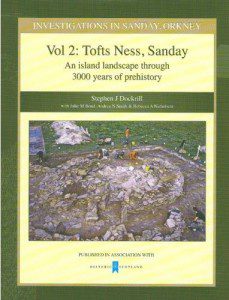Dockrill, SJ 2007 “Investigations in Sanday, Orkney Vol 2: Tofts Ness, Sanday, an island landscape through 3000 years of prehistory” The Orcadian Ltd and Historic Scotland, 417 pages, 288 illus, 83 tables, hardback RRP £38.50 ISBN 978 1 902957 28 9. Reviewed by Dr Simon Gilmour FSA FSAScot MCiFA

Dockrill, SJ 2007 “Investigations in Sanday, Orkney Vol 2: Tofts Ness, Sanday, an island landscape through 3000 years of prehistory”
This handsome, thoroughly illustrated volume encapsulates a detailed analysis of a single site within a landscape context, professionally melding structural and artefactual remains with environmental and economic evidence. Published in 2007 the volume describes work carried out on the Tofts Ness peninsula of Sanday in the mid 1980’s and complements Volume 1, the excavations at Pool on the opposite end of the island; indeed, post-excavation collaboration allows detailed and very welcome comparisons throughout the volume between the two studies. The peninsula is populated by mounds and the remains of field boundaries describing both a settlement and funerary landscape, and a range of methods were employed to investigate these including geophysical survey.
The site of Mound 11 on the Tofts Ness peninsula provides a sequence from the Neolithic to Early Iron Age, with a rare example of continuity of occupation from the Neolithic to Bronze Age. While the best preserved structural evidence was a roundhouse and annex of the Early Iron Age, the Neolithic and Bronze Age sequence has extensive midden evidence associated with some structural remains. Expert analysis of the rich material assemblage gives a fascinating insight into the lives of those living at Tofts Ness, with highlights including a non-decorated ceramic assemblage contemporary with the Grooved Ware assemblages from elsewhere in Orkney, including Pool on Sanday itself, and the various strands of evidence indicating clear links between Tofts Ness and Shetland. The discovery, in Phase 2, of an articulated skeleton of a headless bull dating to between 2820-2560calBC and 21110-1690calBC was striking, especially when compared to the recent discovery of 30 cattle skulls in the wall of a structure at the Links of Noltland recently. Is there a potential link between the two deposits?
What clearly comes through the report is the development over time of the peninsula, and the area of Mound 11 especially, towards a more and more marginal landscape. The increasing demands thus placed on those living at Tofts Ness are reflected not only in the effort expended in the manipulation of the soils around the buildings, but also in the lack of personal ornament and truly functional nature of the artefactual assemblage. The site is eventually abandoned after a particularly severe environmental event, or events, that covered the carefully managed soil of the infields in sand.
The last period of use was during the Early Iron Age, and Tofts Ness has often been used in discussions surrounding the development of brochs, usually as an example of a pre-broch settlement from which the concept of tall circular tower dwellings began to evolve. The detailed analysis of Tofts Ness presented here goes beyond these simplistic notions, and suggests that whatever its links to the broch phenomenon, Tofts Ness was a low status, marginal farmstead, with a very delicate economic and environmental balance preserved by the hard work and perseverance of its occupants. This must impact on our simplistic evolutionary theories of Iron Age Atlantic structures, and highlights the need for a detailed contextual analysis of all the sites used in those theories.
Throughout the volume the evidence used to construct the narrative and some exciting, although admittedly speculative, economic models for the lives of those living on the peninsula over 3000 years are clearly, succinctly and honestly presented. The author does not shy away from making clear the restrictions imposed on his analysis, including practical issues of working in what is still a marginal landscape, and also the methodology and process of archaeology in the 80’s (where this particular landscape study was nevertheless ahead of its time in Atlantic Scotland). This is an exceptionally important contribution to period specific studies, but also an example of what can be done to bring prehistory to life with the use of detailed evidential strands and thoughtful speculation.
Dr Simon Gilmour
